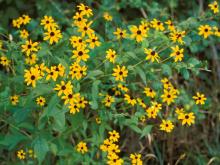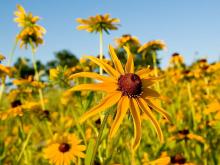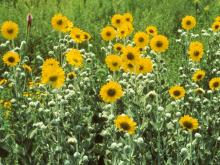Wildflowers, Grasses and Other Nonwoody Plants
Media

Species Types
Scientific Name
Helianthus annuus
Description
Whether you see the wild form or any of the many cultivated varieties, this poster child of the sunflower family cultivates its own sunny impression. Common sunflower is also the state flower of Kansas.
Media

Species Types
Scientific Name
Rudbeckia triloba
Description
Brown-eyed Susan is a bushy perennial with much-branching stems and plenty of flowerheads. Compared to Missouri’s other Rudbeckia species, its flowerheads are the smallest, growing to only about one inch across.
Media

Species Types
Scientific Name
Rudbeckia hirta
Description
Black-eyed Susan is a tremendously popular native wildflower for gardening. It’s also commonly planted along roadways, so when it’s blooming, May through October, you’re sure to see it somewhere.
Media

Species Types
Scientific Name
Helianthus spp.
Description
Most people recognize sunflowers when they see them, with their bright yellow ray flowers and rather flattened center of dark disk flowers. There are 16 species of Helianthus in Missouri.
See Also
About Wildflowers, Grasses and Other Nonwoody Plants in Missouri
A very simple way of thinking about the green world is to divide the vascular plants into two groups: woody and nonwoody (or herbaceous). But this is an artificial division; many plant families include some species that are woody and some that are not. The diversity of nonwoody vascular plants is staggering! Think of all the ferns, grasses, sedges, lilies, peas, sunflowers, nightshades, milkweeds, mustards, mints, and mallows — weeds and wildflowers — and many more!





















